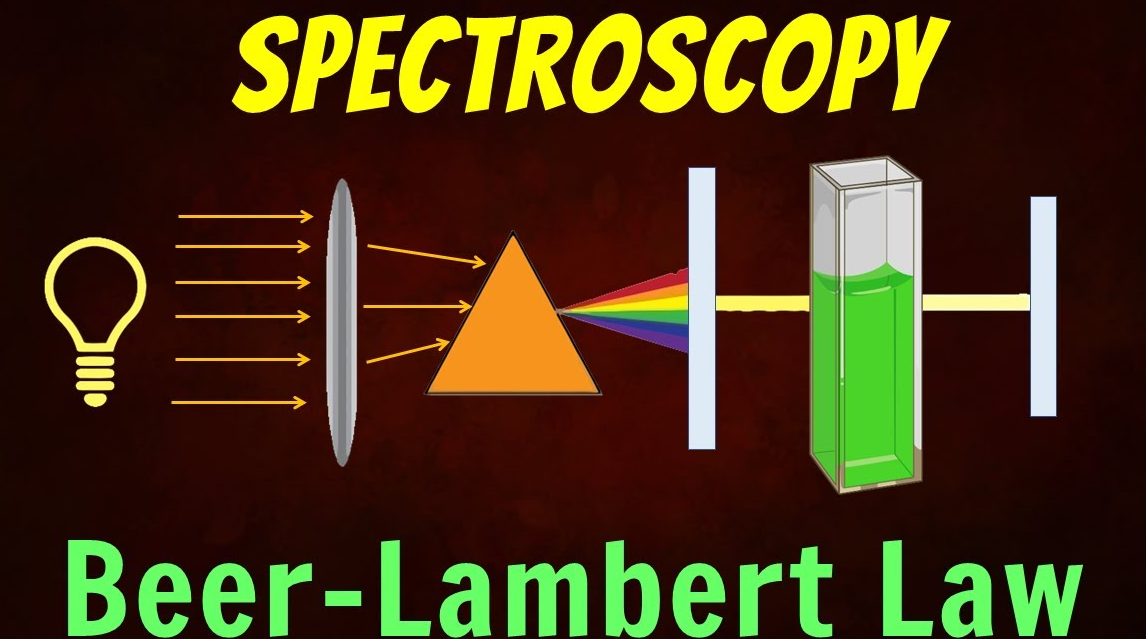The Beer-Lambert Law, often referred to simply as Beer’s Law, is a fundamental principle in the field of analytical chemistry that establishes a relationship between the concentration of a solute in a solution and the absorption of light by that solution.
Named after scientists August Beer and Johann Heinrich Lambert, this law is a cornerstone of spectrophotometry, a widely used technique for quantitative analysis in various scientific disciplines.
बीयर-लैंबर्ट कानून, जिसे अक्सर बीयर के नियम के रूप में जाना जाता है, विश्लेषणात्मक रसायन विज्ञान के क्षेत्र में एक मौलिक सिद्धांत है जो एक समाधान में एक विलेय की एकाग्रता और उस समाधान द्वारा प्रकाश के अवशोषण के बीच संबंध स्थापित करता है।
वैज्ञानिकों ऑगस्ट बीयर और जोहान हेनरिक लैम्बर्ट के नाम पर रखा गया यह कानून स्पेक्ट्रोफोटोमेट्री की आधारशिला है, जो विभिन्न वैज्ञानिक विषयों में मात्रात्मक विश्लेषण के लिए व्यापक रूप से इस्तेमाल की जाने वाली तकनीक है।

Beer-Lambert Law:-
The mathematical expression of the Beer-Lambert Law is given by the equation:-
A=.c.l
- is the absorbance of the sample,
- (epsilon) is the molar absorptivity or molar extinction coefficient,
- is the concentration of the solute in the solution, typically measured in moles per liter (M),
- is the path length of the light through the solution, measured in centimeters.
This law forms the basis for understanding and quantifying the interaction between light and matter in a solution. Let’s delve into the key aspects and applications of the Beer-Lambert Law.
1.Conceptual Foundation: The Beer-Lambert Law is rooted in the principle that the amount of light absorbed by a solution is directly proportional to the concentration of the absorbing solute and the path length of the light. This relationship holds true under ideal conditions, assuming dilute solutions where the interactions between solute molecules are minimal.
2. Absorbance and Transmittance: Absorbance () is a measure of the amount of light absorbed by a solution, and it is related to transmittance (), the fraction of light that passes through the solution. The relationship is given by =−log10(. Therefore, as absorbance increases, transmittance decreases.
3. Molar Absorptivity (): Molar absorptivity is a constant specific to a given solute at a specific wavelength. It quantifies how strongly a substance absorbs light. Substances with higher molar absorptivities absorb more light and, consequently, exhibit higher absorbance values for a given concentration and path length.
4. Concentration Dependence: One of the fundamental applications of the Beer-Lambert Law is in the determination of the concentration of a solute in a solution. By measuring the absorbance of a sample and knowing the molar absorptivity and path length, the concentration of the solute can be calculated. This is particularly valuable in fields such as chemistry, biochemistry, and environmental science.
5. Wavelength Dependency: The absorbance of a substance is wavelength-dependent, meaning that different substances exhibit unique absorption spectra. By analyzing the absorbance at specific wavelengths, scientists can identify and quantify different substances in a mixture.
6. Spectrophotometry: Spectrophotometry is the primary technique used to apply the Beer-Lambert Law experimentally. In this technique, a spectrophotometer measures the intensity of light before and after it passes through a sample solution. The resulting data are used to calculate absorbance, allowing for the determination of concentration.
7. Deviations and Limitations: While the Beer-Lambert Law is a powerful tool, deviations can occur at high concentrations due to factors such as solute-solute interactions, molecular aggregation, and changes in the refractive index. At elevated concentrations, the linearity of the relationship between absorbance and concentration may break down.
In conclusion, the Beer-Lambert Law provides a robust framework for quantitative analysis in chemistry and related fields. Its applications extend from determining concentrations of solutes in laboratory settings to environmental monitoring and pharmaceutical quality control. By understanding the principles behind this law, scientists can unravel valuable information about the composition and concentration of substances in solution, contributing to advancements in research and technology.
For More information visit web :-https://xeidea.com/
And news website:– https://lokprasang.com/

